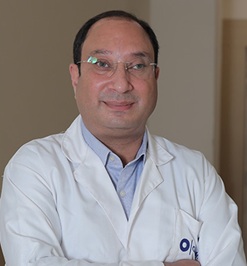ACL Reconstruction Surgery - Procedure, Benefits & Risks

Treatment Duration
30 Minutes
------ To ------45 Minutes
Treatment Cost
₹ 45,000
------ To ------₹ 2,00,000

Table of Contents
- What is ACL Reconstruction Surgery?
- What are the Benefits of ACL Reconstruction Surgery?
- Who needs ACL Reconstruction Surgery?
- How is ACL Reconstruction Surgery done?
- What to expect before surgery?
- What to expect on the day of surgery?
- What to expect after surgery?
- What are Risks and Complications of ACL Reconstruction?
You can check ACL Reconstruction Surgery Cost here.
What is ACL Reconstruction Surgery?
ACL surgery is done to repair or reconstruct an ACL (Anterior Cruciate Ligament) tear in the knee. The ACL tear or injuries occur mostly in people involved in sports like football, volleyball, basketball, etc. This procedure is done by an orthopaedic surgeon who specialises in bones and joints. ACL surgery uses a graft to replace the torn ligament.
The ACL is one of the major ligaments in the knee joint. It is a band of dense connective tissue extending from the femur to the tibia which assists in stabilising and supporting the knee joint during bending and rotation and also prevents the knee from gliding anteriorly.
The ACL has two components:
AnteroMedial Bundle(AMB)
PosteroLateral Bundle(PLB).
ACL Reconstruction Surgery Videos by HexaHealth
Expert Doctors (10)
NABH Accredited Hospitals (10)


What are the Benefits of ACL Reconstruction Surgery?
- Less operative time
- Smaller incisions
- Less post-operative pain
- Aid in the ability to return to daily sports activity,
- After the age of 60 decreases the increase in the incidence of arthritis.
- High success rate
Who needs ACL Reconstruction Surgery?
- ACL surgery is done to restore the normal functioning of the knee joint and to stabilise it in case you injure or tear your ligament during sports and fitness activity.
- To relieve ACL tear symptoms like:
- Pain, which is of severe intensity and an inability to continue any activity
- Rapid swelling in your knee
- Loss of range of movement
- You might feel like your knee is not bearing your weight
- Popping sensation in your knee
-
It is most commonly done with young athletes who wish to continue the sport.
-
Your doctor recommends it, if your knee injury interferes with daily activity and if there is more than one ligament involved in the injury.
How is ACL Reconstruction Surgery done?
- ACL is either repaired, i.e., stitched back together or reconstructed. Most ACL surgeries require reconstruction.
- ACL reconstruction surgery is done through a minimally invasive arthroscopic procedure.
- Your orthopaedic surgeon will reconstruct the ligament with a graft.
- The graft can be an autograft (tissue from your own body) or an allograft (tissue from donor).
- The most commonly used grafts are hamstring tendon, patellar tendon, quadriceps tendon, or cadaver tendon.
- You will be administered either general or regional anaesthesia.
- During arthroscopic ACL reconstruction, your surgeon will make several small incisions around the knee.
- Then, the sterile saline (salt) solution is poured into the knee through one incision to expand it and wash away the blood, allowing the doctor to see the knee structures more clearly.
- Your surgeon will insert an arthroscope into one of the incisions. It has a camera at the end which transmits pictures from inside the knee to a TV monitor.
- Afterwards, surgical drills are inserted. Your surgeon will drill small holes into the lower and upper leg bones at the knee joint. These holes will form the tunnels through which the graft will be inserted for scaffolding.
- If it is your own tissue, the surgeon will make another incision in the knee and take the graft.
- The graft is pulled through the tunnels. The surgeon will then tighten the graft screws or staples and close the incisions with stitches or tape. Your knee is then bandaged, and you are shifted to the recovery room for observation.
- During ACL surgery, your surgeon will also repair other injured parts of the knee joint, such as menisci or other knee ligaments.

What to expect before surgery?
- Your surgeon will decide if your tear needs surgery. A minor tear heals on its own.
- The doctor will examine your knee and check for pain, swelling, and tenderness.
- If your knee has swelling and your joint movement is limited, you will be advised to wait for any swelling to go and for the full range of motion to return.
- It usually takes 3 weeks to return to normal.
- You may be referred to a physiotherapist who will show you some stretches and exercises to do at home, so that your joints become flexible.
- After 3 weeks, if you have gained full range of joint movement, your doctor will run some blood tests and will ask you about your medications.
- If you take any aspirin related medicines, you will be advised to stop at least a week before that.
- You will be told to fast for at least six hours before surgery.
What to expect on the day of surgery?
- You should reach the hospital on time.
- You will be provided with a consent form to be signed, giving the surgeon permission to perform the surgery and providing emergency care in case of any untoward complication.
- You will be asked to wear a gown.
- It is usually an outpatient surgery, so you will need a family member to drive you home.
What to expect during surgery?
- You will be taken to the operation theatre.
- You will then be administered the anaesthesia and IV lines.
- Your vitals will be monitored.
- Your knee will be cleansed with an antiseptic solution, mostly povidone or iodine.
- The surgeon will then make a small incision and perform the procedure using an arthroscope.
- It takes 1-3 hours to carry out this procedure.
- Your surgeon will tie a bandage around your knee after the surgery is over.
- You will then be sent to the recovery room for a few hours.
What to expect after surgery?
- You can go home after 2-3 hours.
- After the surgery, you will be able to walk with crutches or leg braces.
- You will be prescribed painkillers like ibuprofen, acetaminophen, and antibiotics.
- You will be asked to keep your wound clean and dry.
- You will be advised to look for any signs of infection.
- For the ligament to heal completely, it might take 6 - 9 months.
- Soon after surgery, you will be asked to enter a rehabilitation program to strengthen your muscles and restore stability and the full range of joint motion.
- It will consist of strengthening exercises, running exercises at 4 months, pivoting exercises at 5 months, and competitive exercises at 6 months.
First follow-up appointment
- It is usually within 4-6 weeks. Your doctor will inform you based on your condition
- You will need to consult your doctor earlier if you see any unusual signs like:
- Pain that is not relieved on medication
- Bleeding or blood clots
- Fever
- Chills
What are Risks and Complications of ACL Reconstruction?
ACL reconstruction surgery is mostly safe. Complications that can arise from surgery or during rehabilitation include:
- You can experience problems related to the surgery like:
- Numbness in the area.
- Infection in the surgical wound.
- Damage to structures, nerves, or blood vessels.
- You may have blood clots in the leg.
- Experience problems with the tendon graft (loosening, stretching, reinjury, or scar tissue), and the screws attached may require removal.
- Grating of the patella (crepitus) may develop, which can be painful and may limit sports activity.
- In case of excruciating pain, when kneeling, at the site where the graft was anchored.
If you possess these symptoms, consult your doctor.
Last Updated on: 3 May 2023
Author
HexaHealth Care Team
HexaHealth Care Team brings you medical content covering many important conditions, procedures falling under different medical specialities. The content published is thoroughly reviewed by our panel of qualified doctors for its accuracy and relevance.


























